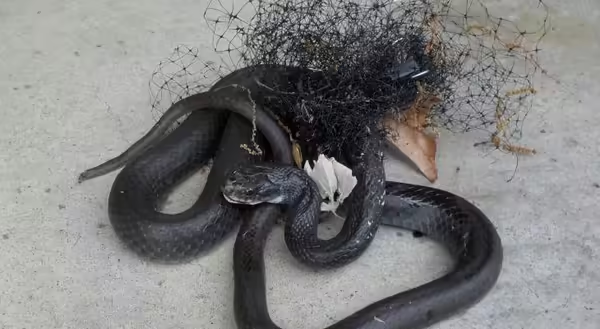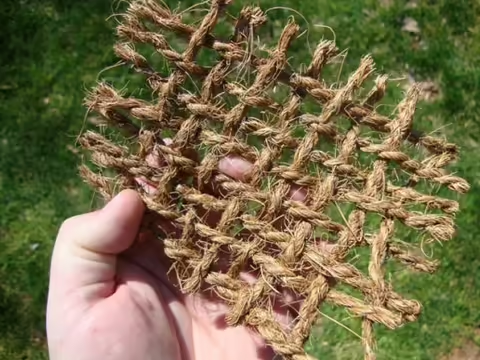
Have you placed mesh material in your garden or around the outside of your home? Mesh, whether made from metal or plastic, or natural fibers, can be incredibly useful because it allows air, water, and plants to penetrate while keeping out larger objects. Some folks use it to keep birds off their berry bushes, others may place a mesh fence around their garden to keep deer out. While driving in a construction zone, you may also observe that blankets of mesh are used for erosion control on steep slopes on roadsides.
Unfortunately, mesh used in natural landscapes can be dangerous for wildlife — especially for snakes. Many types of mesh barriers are known to trap snakes, birds, turtles, frogs, and more.
Animals trapped in mesh netting may quickly die from exposure to the sun or may suffer injuries while trying to escape. In Wisconsin, Professor Josh Kapfer and colleagues found 22 fox snakes entangled in erosion control blankets on one June day. They were able to release 16 snakes but the others had perished. In another part of Wisconsin, Professor Kapfer reports a large bullsnake was found entangled in plastic mesh around a strawberry bed. Thankfully, the snake was set free.
Moving toward wildlife-friendly erosion control
After finding many animals trapped or killed, biologists began raising alarms about the widespread use of mesh, and their concerns led some states to change the types of erosion control mats used along roadsides and in construction projects. Two studies examining erosion control products found that products containing a plastic mesh were the most dangerous to snakes, especially large snakes.
Wildlife-friendly erosion control products are made of loosely woven organic materials like wheat straw or coconut fiber with large holes that allow snakes to pass through. Nationwide, the transportation industry is trending towards more widespread use of wildlife-friendly erosion control products, with the goal of protecting threatened and endangered animals and keeping microplastics out of the environment.
Efforts in Illinois
Kimberly Burkwald of the Illinois Department of Transportation tells me they are sponsoring a study on the effectiveness of different erosion control mats, with the goal of finding products safe for wildlife and effective at erosion control. Changing states’ erosion control practices is important because these products are used across large areas and are not always monitored for wildlife entrapment.
Mesh in backyards
What happens in your backyard is also important to snake conservation. Kathy Coffman from Cape Girardeau, Missouri, described a traumatic event that took place in her yard, which is full of native vegetation planted to benefit wildlife. She and her husband share the landscape with plenty of deer and groundhogs, both of which like to nibble on the plants. Thus, she covered her plants with a plastic mesh netting to deter them. One day she noticed a large snake trapped in a bundle of netting in the yard, but when she and her husband went back out to find it, the snake was gone. Four days later, they found the snake again, still entangled in the mesh. A herpetologist friend named John Palis came to retrieve the snake but, sadly, it was nearly dead and didn’t survive its injuries. Kathy says she has no mesh in her yard now. When she planted a dogwood tree this summer, she put a tomato cage around the sapling to protect it.
Alternatives to mesh
Even if you monitor your garden every day, I recommend that you look for alternatives to mesh or use wildlife-friendly mesh. Oftentimes in the garden, mesh is used as a barrier to wildlife. Try using stiff, woven wire fencing like chicken wire to keep wildlife out of the garden. Or you could hang flagging or flashy pie pans from a line or construct a scarecrow to keep birds and deer away from your crops. Installing bird or bat houses on metal poles or using baffles on the post could help keep predators like snakes and raccoons from climbing the post.
Look for mesh in the environment and let others know about the dangers these products pose to animals. If we all make a concerted effort to find alternatives to plastic mesh, we’ll make our backyards, parks, and other natural spaces much safer for the wildlife which coexist with us.
Please let me know if you are successful in switching to an alternative product or convincing someone else to do so. You can reach me at jmokeefe@illinois.edu.
Main photo credit: A racer snake entangled in mesh. Photo by John Palis.
MEET THE AUTHOR
This is a guest blog by Dr. Joy O'Keefe, University of Illinois Assistant Professor and Wildlife Extension Specialist. Her research primarily focuses on ways to facilitate the coexistence of bats and humans in human-altered landscapes. She works to understand the roosting and foraging ecology of bats, identify best practices for studying bat ecology, characterize bat behaviors, and assess the quality of mitigation practices designed to help bats. Dr. O'Keefe collaborates with many organizations and people who interact with bats, including private landowners, USDA Forest Service, National Park Service, and state agencies.
ABOUT THE BLOG
Naturalist News is a blog by University of Illinois Extension Master Naturalist staff and volunteers who bring you stories highlighting the individuals, places, wildlife, and plants that make this state amazing. Join us each week to learn something new, be inspired, and become connected to your own community by recognizing the amazing ways we are all intertwined. Want to get notified when new Naturalist News posts are available? SIGN UP HERE!
